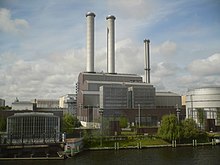
Back Gaskraftwerk German Maakaasuvoima Finnish Gázerőmű Hungarian Centrale a gas Italian Gascentrale Dutch Gasskraftverk NN Gasskraftverk NB Gas-fired power plant SIMPLE 燃氣發電 Chinese


2021 world electricity generation by source. Total generation was 28 petawatt-hours.[1]
A gas-fired power plant, sometimes referred to as gas-fired power station, natural gas power plant, or methane gas power plant, is a thermal power station that burns natural gas to generate electricity. Gas-fired power plants generate almost a quarter of world electricity and are significant sources of greenhouse gas emissions.[2] However, they can provide seasonal, dispatchable energy generation to compensate for variable renewable energy deficits, where hydropower or interconnectors are not available. In the early 2020s batteries became competitive with gas peaker plants.[3]
- ^ "Yearly electricity data". ember-climate.org. 6 December 2023. Retrieved 23 December 2023.
- ^ "Clean fuel? Methane leaks threaten natural gas' climate-friendly image". Reuters. 29 June 2018. Archived from the original on 15 February 2019. Retrieved 30 June 2019.
- ^ Mcfarlane, Sarah; Twidale, Susanna (21 November 2023). "Giant batteries drain economics of gas power plants". Reuters. Retrieved 21 November 2023.
© MMXXIII Rich X Search. We shall prevail. All rights reserved. Rich X Search